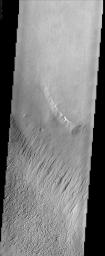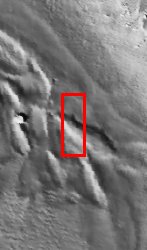
|
Yardangs in Medusa Fossae
- Click the image above for a larger view
- Full-Res JPEG (1239 x 3043) (648.6 kB)
- Full-Res TIFF (1239 x 3043) (1.9 MB)
Caption:

(Released 29 July 2002)
This THEMIS visible image covers a portion of the Medusa Fossae formation, near the equator of Mars. The most characteristic feature of the Medusa Fossae formation is the abundance of "yardangs," which are erosional landforms carved by the wind. These features usually form in a linear fashion, and can be indicators of prevailing paleowind directions. On Earth, yardangs are typically found in rocks that are easily eroded, such as those that form from consolidated volcanic ash, dust-fall deposits or lake sediments.
In this particular area of Medusa Fossae, the size, spacing, and orientation of the yardangs varies throughout the image. The largest form a stripe across the center of the image, while the smallest are found in the top half of the image (look closely). The small yardangs at the very top of the image are oriented NW-SE; however, the orientation changes to NE-SW near the bright ridge in the center of the image. The variation in size and orientation appears to correspond with topographic layers, and may be due either to differences in consolidation or changes in wind strength or direction as the yardangs were formed. Finally, the terrain in the lower third of the image appears etched or pitted, and was probably also formed by wind erosion.
Cataloging Keywords:
| Name | Value | Additional Values |
|---|---|---|
| Target | Mars | |
| System | ||
| Target Type | Planet | |
| Mission | 2001 Mars Odyssey | |
| Instrument Host | Mars Odyssey | |
| Host Type | Orbiter | |
| Instrument | Thermal Emission Imaging System (THEMIS) | |
| Detector | ||
| Extra Keywords | Dust, Grayscale, Volcano | |
| Acquisition Date | ||
| Release Date | 2002-08-05 | |
| Date in Caption | 2002-07-29 | |
| Image Credit | NASA/JPL/Arizona State University | |
| Source | photojournal.jpl.nasa.gov/catalog/PIA03908 | |
| Identifier | PIA03908 | |
